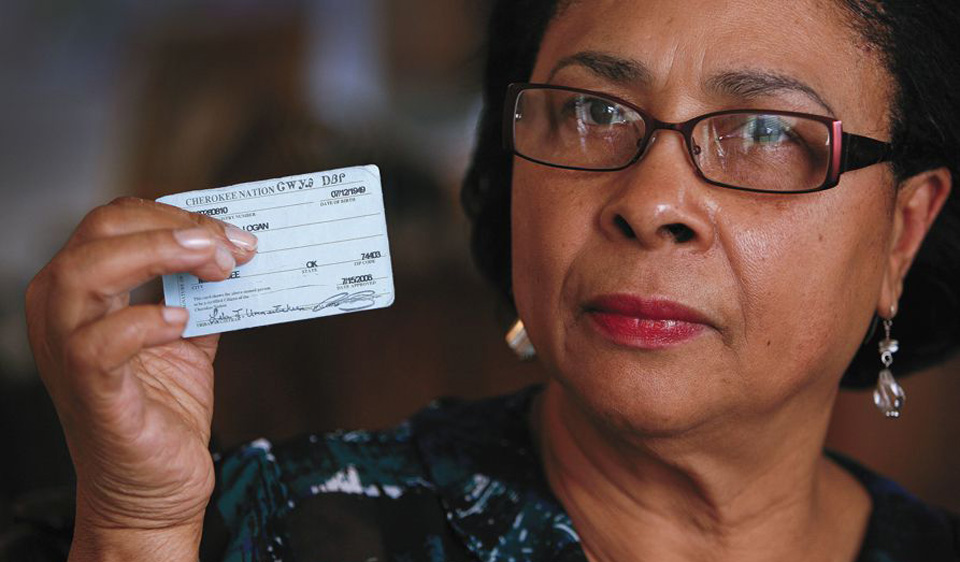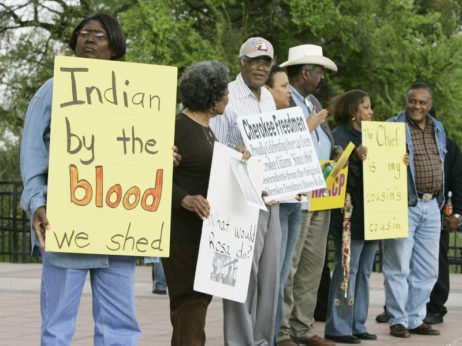
Late last summer, after more than a decade of legal battles, a U.S. federal court ruled that the rights enjoyed by members of the Cherokee Nation also extend to the descendants of the slaves owned by the Nation before the Civil War.
The court upheld an 1866 treaty between the U.S. government and the Cherokee Nation which granted “all the rights of native Cherokees,” including citizenship in the Nation, to their liberated slaves—the Cherokee Freedmen—and their descendants.
After this ruling, according to the Cherokee Phoenix, the Attorney General of the Cherokee Nation of Oklahoma, Todd Hembree, announced “that he would not appeal the court’s ruling,” likely bringing an end to the long-running conflict between Freedmen descendants and the Cherokees.
In 2007, the Cherokee Nation voted to amend its constitution to limit membership to only those persons descended from ancestors listed as “Cherokee by blood” on the original Dawes Rolls registry of Native Americans. This eliminated the citizenship rights of those descended from Cherokee Freedmen who were also on the same roll.
The Cherokee Freedmen are only the most recent group of freedmen to regain citizenship. The Seminole Freedmen descended from escaped slaves that joined the Seminole Nation in Florida and traveled with them along the Trail of Tears, previously won back some rights. There are still others, however, who are excluded by their respective indigenous governments.
The history of the Native American Freedmen is not widely known. One of the reasons why many don’t know this history is that out of over 500 federally recognized tribes, only five ever practiced chattel slavery. But even those who are familiar with some part of the story often believe a number of common myths.
One of them is that the Cherokee, Muscogee (Creek), Choctaw, and Chickasaw weren’t engaged in actual slavery. It is widely believed that they were just buying slaves to either set them free or to free Black family members. This wasn’t really the case. These tribes—four of the Eurocentrically-termed “Five Civilized Tribes”—did engage in the practice of slavery, aided and encouraged by the U.S. government.
The U.S. encouraged slavery among the tribes in the southeastern United States to accomplish two goals. One was to “breed out” the native population by having them mix with white settlers and adopt the practice of chattel slavery. Cultural assimilation efforts would later take the form of forcefully sending indigenous children into boarding schools. Another goal was to keep Native Americans from protecting Black slaves who ran away from white plantations.
Encouraging the adoption of slavery was a second-best effort. Early on, colonists attempted to enslave indigenous people themselves. This was met with a number of difficulties, a major one being that diseases like smallpox killed so many indigenous people. Additionally, given that the indigenous were on their own land and knew it better than the colonists, escape was far easier for them.
Though Native Americans proved difficult to enslave, at least some tribes were enticed into becoming slaveowners. The Black people that were owned as slaves by the Cherokee, Choctaw, Chickasaw, and Muscogee (Creek) Nations were mostly owned by either intermarried whites or their mixed blood descendants.
In the southern United States, the system of chattel slavery conferred a vast amount of power and influence on slave owners and shaped the destiny of the country. It was no different among the Cherokee, Chickasaw, Choctaw, and Muscogee (Creek) Nations. Slavery among the five indigenous nations in the southeastern United States often mirrored practices in the rest of the South.
The Indian Removal Act of 1830 forced most of the indigenous nations in the southeastern United States to relocate west of the Mississippi along the Trail of Tears. That part of history is well known, but what is often overlooked is the fact that those nations who held slaves took them with them in the move. They would continue to keep them in bondage until the end of the Civil War in 1865.
At that time, the United States government negotiated new treaties with each of the indigenous nations. Enshrined into those agreements were the citizenship rights of the now-freed Blacks. Out of the five indigenous nations, only four granted freedmen citizenship. Freedmen were given a choice to take U.S citizenship instead, an option similar to that given to indigenous people if they chose to stay in their ancestral homelands rather than travel westward on the Trail of Tears.
The Dawes Commission, established by the U.S government in 1893, removed sovereignty and distributed land to freedmen and indigenous citizens on an individual basis. Freedmen, however, were granted less land than citizens by blood or by marriage. According to the Chickasaw Nation of Oklahoma, “Choctaw freedmen and their descendants would each get forty acre allotments, but no share of the other tribal resources.”
Often, those with mixed Black and Native American heritage were listed as freedmen instead of “by blood.” “Mixed-blood black Indians were all enrolled as freedmen with no Indian blood,” according to Linda Reese of the Oklahoma Historical Society. “When stalling tactics failed the Indian governments, they used every measure at their disposal to limit the number of freedmen admitted to the rolls.”
It was really up to individual U.S. commissioners to determine if someone would be listed as a freedman, usually on the basis of whether they looked Black enough. Once free, many of the freedmen started looking for family members that had been sold to different plantations. They gathered into small settlements with their families, and some of these towns still exist in Oklahoma today.

With the ruling in the Cherokee case, the descendants of the Native American freedmen have now gained citizenship in the Seminole and Cherokee Nations, though it is still limited in the former. Both of these groups of freedmen descendants regained their citizenship rights following court decisions.
The Muscogee (Creek) Freedmen, however, lost their citizenship in 1979, the Choctaw Freedmen in 1983, and the Chickasaw Freedmen were never granted full citizenship. Some of the descendants of the Freedmen of the Muscogee (Creek) Nation of Oklahoma have chosen a different route than seeking to have their citizenship rights restored. Instead, they have formed the “Muscogee Creek Indian Freedmen Band” and have sought federal recognition from the United States.
After the ruling that restored the Cherokee Freedmen descendants’ citizenship rights, the Tulsa World reported that “the Chickasaw, Choctaw, Creek, and Seminole nations are each at various stages of acceptance of Freedmen as full citizens of their tribes.” It will likely take many more lawsuits, however, before all the freedmen are restored the rights taken away from them.
For more information, visit the website of the Descendants of the Freedmen of the Five Civilized Tribes.










